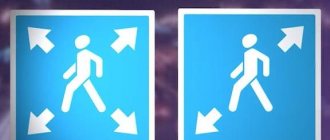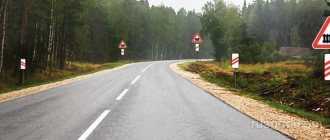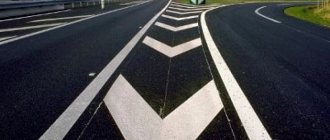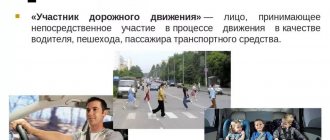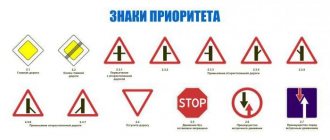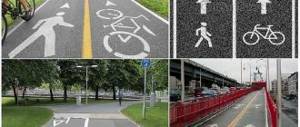Good afternoon, dear reader.
In this article we will talk about traffic signs , which are covered in Appendix 1 “Road Signs” to the traffic rules.
This article is the first article in the “Traffic Signs” series and it examines the most basic features of road signs: the division of signs into groups, the designations of each group, the features of their use.
Types of road signs in 2021
Currently, Appendix 1 to the Traffic Regulations has 8 sections, each of which deals with a separate group of road signs:
- warning signs;
- priority signs;
- prohibition signs;
- prescriptive signs;
- signs of special regulations;
- information signs;
- service marks;
- additional information signs.
Road signs are divided into groups in such a way that each group contains signs that are similar in meaning. Let's look at each type of sign in more detail.
Traffic warning signs
Warning road signs are the most useful and safest signs for a driver. Their safety lies in the fact that the requirements of warning signs cannot be violated , because These signs do not prohibit or restrict the driver. The main function of such signs follows from their name. They warn the driver about possible dangers and help avoid road accidents.
Warning signs are installed on dangerous sections of roads and can be easily distinguished from all other signs. Most warning signs look like a red triangle:
The only exceptions are signs related to railway crossings and “turn direction” signs. Their shape differs from a triangle:
Please note that all other warning signs are triangles .
Let me remind you once again that it is impossible to violate the requirements of warning signs, therefore, in the area of their coverage, a fine for violating the requirements of road signs in the amount of 500 rubles cannot be imposed.
However, warning road signs can warn you against violations that can result in very real penalties.
Consider an example with a “ dangerous turn ” sign:
If you come across a similar sign on the road, then you do not need to take any special action. However, you should keep in mind that after 150 - 300 meters outside a populated area or after 50 - 100 meters in a populated area there will be a dangerous turn on your way.
At a dangerous turn, overtaking is prohibited (clause 11.4 of the rules). Accordingly, for overtaking on a dangerous turn, the driver risks being punished in the form of deprivation of a driver’s license for 4-6 months or a fine of 5,000 rubles.
At the same time, the rules do not prohibit overtaking after the “dangerous turn” sign, but before the start of the most dangerous turn.
More detailed information about warning road signs is provided in the following articles:
Warning signs 1.1 - 1.12 Warning signs 1.13 - 1.23 Warning signs 1.24 - 1.35
New sign “Photo and video recording”
Starting this year, a new information sign “Photo and video recording” will appear on the roads. It will be used to designate areas of possible use of special means that have the function of photo or video recording of traffic violations. Outside the populated area, the sign will be installed at a distance of 150-300 m before the start of the fixation zone. In populated areas only at the entrance along with a sign indicating the name of the populated area. The new sign will inform drivers about cameras on highways in advance, while the warning will disappear in populated areas.
If previously a sign with a camera image was installed only in conjunction with other signs such as: speed limit, prohibition of overtaking, etc., now it is installed independently of other signs. The “Photo and Video Recording” sign will replace signs with a camera image.
Priority signs
Priority signs, unlike warning signs, establish priority right of passage at intersections, intersections of roadways, and narrow sections of the road.
In this case, you should pay attention that for violating the requirements of priority signs installed at an intersection, you can receive a fine of 1,000 rubles (Part 2 of Article 12.13 of the Administrative Code). For the same violation outside an intersection, a warning or a fine of 500 rubles may be imposed (Part 1 of Article 12.16 of the Administrative Code).
There are only 13 priority signs, so it’s quite easy to remember them even though they all have different shapes and colors.
Priority signs
Prohibition signs
The signs of this fairly large group introduce prohibitions and restrictions. A ban implies that further movement is impossible. The restriction allows you to continue driving, but subject to certain conditions.
All prohibition signs are round in shape. Most of them are a black image on a white background, surrounded by a red border. Four prohibition signs have a blue background. Four more signs that lift previously introduced restrictions have a black and white color scheme.
Studying prohibition signs poses two difficulties.
Firstly, different signs in this group have different exceptions that you will have to remember.
Secondly, if a prohibitory sign without a sign begins to operate immediately from the place where it is installed, then it can be difficult to understand where the restriction it introduced ends.
Different prohibition signs have different coverage areas, and you will also have to learn them.
Who is not covered by the prohibition signs:
1. Drivers of vehicles with a blue (or red-blue) flashing light and siren on, as well as drivers of vehicles accompanied by them, when performing an urgent official task, have the right to deviate from the requirements of any road signs, including prohibitory ones.
For other vehicles:
2. The requirements of signs 3.16, 3.17.1, 3.17.2, 3.17.3, 3.20, 3.24 are mandatory for all drivers.
3. Signs 3.1, 3.2, 3.3, 3.18.1, 3.18.2, 3.19, 3.27 do not apply to route vehicles.
4. Signs 3.2, 3.3, 3.4, 3.5, 3.6, 3.7, 3.8, 3.28, 3.29, 3.30 do not apply to postal vehicles.
5. Signs 3.2, 3.3, 3.28, 3.29, 3.30 do not apply to vehicles transporting disabled people of the 1st or 2nd group and disabled children.
6. Signs 3.2, 3.3, 3.5, 3.6, 3.7, 3.8 do not apply to vehicles that serve enterprises located in the designated area or transport citizens living or working in the designated area.
7. Signs 3.28, 3.29 and 3.30 do not apply to taxis with meters turned on. There is no exception for those who live or work in the area covered by these signs.
8. Sign 3.26 does not prohibit the sound signal in an emergency to prevent an accident.
9. Sign 3.20 allows you to overtake vehicles that, by their design, are not capable of reaching a speed of more than 30 km/h, as well as horse-drawn carts, two-wheeled motorcycles, mopeds and bicycles. At the same time, sign 3.22 does not allow trucks with a permissible maximum weight of more than 3.5 tons to overtake any vehicles.
Areas of operation of prohibitory signs Prohibitory signs that impose restrictions have four main areas of coverage:
- to the nearest intersection (except for intersections with field and forest dirt roads, which are not indicated by signs installed at intersections);
- if the sign was installed in a populated area and there was no intersection on the way - up to the “End of populated area” sign 5.24.1, 5.24.2;
- in accordance with the “Area of Operation” plate 8.2.1 with which the sign is installed. In this case, the length of the restricted zone is indicated on the sign;
- to the 3.31 sign.
In addition, signs 3.20, 3.22 and 3.24 have a fifth coverage zone - up to signs 3.21, 3.23 and 3.25, respectively.
Sign 3.24 can also be valid before the same sign with a different speed limit 3.24 (60 km/h), and if it was installed on a country road - before the “Beginning of a populated area” sign 5.23.1, 5.23.2.
Finally, the coverage area of signs 3.27, 3.28, 3.29 and 3.30 can be determined by the length of the yellow marking line applied along the edge of the roadway, or by signs 8.2.2, 8.2.4 and 8.2.3, indicating, respectively, the beginning, continuation and end of the sign's coverage area .
Prohibition road signs
As the title of the section suggests, prohibition signs prohibit the driver from performing certain actions. This section is quite extensive, and it is not always possible to determine their meanings from images of signs. More detailed information about prohibition signs is presented in the following articles:
Prohibitory signs 3.1 - 3.5 Prohibition signs 3.6 - 3.10 Prohibition signs 3.11 - 3.16
Prohibitory signs 3.17 - 3.19 Prohibition signs 3.20 - 3.26 Prohibition signs 3.27 - 3.33
Here I would like to note that most often you can find the following road signs on the road:
| entry prohibited (brick road sign) |
| Movement Prohibition |
| turning is prohibited |
| overtaking is prohibited |
| maximum speed limit |
| stopping is prohibited |
| No parking |
Let's consider an example related to violation of the requirements of a road sign prohibited entry (brick). The punishment for this violation directly depends on which road the driver takes.
If the sign is installed before entering the territory of the organization or the courtyard area, then we are talking about a regular violation of the requirements of road signs (500 rubles).
If a sign prohibits entry onto a one-way road, then a violation will entail a fine of 5,000 rubles or deprivation of rights for a period of 4 to 6 months.
Subgroups of limiting signals
It is believed that signs introducing a “taboo” on a particular action are the most difficult category to study and remember among all traffic rules. And there are several reasons for this:
- the group is quite large;
- they can be found more often than others;
- The principle of “work” has a lot of nuances.
All these features make studying signals difficult. To make the process easier, limiting pointers can be broken down into several subcategories.
3.1–3.10, 3.32 and 3.33
A category of signs that introduces a certain prohibition: either entering a specific area or moving around it. It includes the “Brick” familiar to many, as well as signals associated with some type of equipment (bicycles, trucks, cars, horse-drawn carts, vehicles with trailers, motorcycles, etc.), as well as pedestrians. For example, if sign 3.6 “Tractor traffic is prohibited” is installed, this means that any tractors and self-propelled equipment are not allowed to move in this area.
Formally, these signs do not have a scope: the signals “work” only in the place where they are installed. In other words, if a driver drives under a sign from another territory, he will not violate anything and will be able to continue driving.
3.11–3.15
Signs restricting the movement of vehicles exceeding a specific size or weight. Such signals can usually be found in front of sections of the lane, movement along which is impossible without some “taboo”: a tunnel, a bridge, a railway crossing, a narrow section, a pipeline, and so on.
3.17.1–3.17.3
Signs prohibiting further movement without a mandatory stop. The owner of the vehicle will be able to continue the trip only if he receives the appropriate pass from the officials supervising a certain section of the route: a customs officer, the Ministry of Emergency Situations, the traffic police, a checkpoint and others.
3.18.1, 3.18.2, 3.19
Signs limiting movement in certain positions - left, right, turn. A car enthusiast, having seen these plates, should know a couple of important nuances:
- signs can be installed exclusively in front of road intersections - entrances to the adjacent territory, intersections;
- signs limit only a specific maneuver - other actions are permitted.
3.16, 3.20–3.31
Signals that set and about movement in a certain mode. They are mounted as follows: the limiting signal is placed first, and after a certain interval a sign is mounted that cancels the effect of the first one. The peculiarity of this category is its distribution area:
- to the nearest intersection;
- to the boundaries of the populated area;
- to the place where 3.31 “Cancel all restrictions” is installed.
Mandatory signs
Mandatory road signs are the opposite of the prohibitory signs discussed above. Mandatory signs allow only certain road users to perform certain actions.
For example, a road sign “bicycle path” allows only cyclists:
Various fines may be imposed for violating the requirements of mandatory signs.
For example, for driving onto a pedestrian path, the driver will receive a fine of 2,000 rubles (Part 2 of Article 12.15 of the Administrative Code).
Mandatory signs 4.1 - 4.2 Mandatory signs 4.3 - 4.8
New standard sizes of road signs
To create a comfortable urban environment and improve visibility, the following standard sizes of road signs are recommended:
- “500” - on a low-speed road network;
- “400” - in the central parts of cities, in places of dense and historical buildings, as well as along bicycle lanes, bicycle and pedestrian zones located in any part of the city.
New standard sizes of road signs
Signs of special regulations
Signs of special regulations combine elements of both prohibitory and prescriptive signs.
For example, sign 5.19.1 “pedestrian crossing” allows pedestrians to cross the roadway, and sign “maximum speed limit zone” prohibits speeding on a selected section of the road.
Penalties for violating the requirements of special regulations signs depend on the type of sign and can vary widely.
Signs of special regulations 5.1 - 5.7 Signs of special regulations 5.8 - 5.14 Signs of special regulations 5.15
Signs of special regulations 5.16 - 5.20 Signs of special regulations 5.21 - 5.26 Signs of special regulations 5.27 - 5.34
Additional information signs (plates)
Additional information signs serve to clarify the meanings of road signs from other sections.
For example, a “wet surface” sign indicates that the sign applies only to the period of time when the road surface is wet.
The above combination of signs means that overtaking on the road is prohibited only when the surface is wet.
There are no separate fines for violating the requirements of Section 8 signs. In this case, the type of punishment is determined by the sign, which is the main one and is located above the sign.
Plates 8.1 - 8.2Plates 8.3 - 8.5.3Plates 8.5.4 - 8.9
Plates 8.10 - 8.16Plates 8.17 - 8.22.3
What the new parking and prohibition road signs look like
Signs 3.27d, 3.28d, 3.29d and 3.30d, which prohibit parking and stopping, are installed perpendicular to the main signs, including on fences and walls of various structures. The arrows reflected at the boundaries of the zones indicate the boundaries of the zones where stopping and parking are prohibited.
Signs indicating traffic in the opposite direction
Such road signs are used on sections of roads where, in addition to the opposite direction, traffic in other directions is prohibited.
Signs informing about the direction of movement along the lanes
These signs provide the driver with information about the directions of movement along the lanes that are permitted. In this case, the free arrangement of the booms is allowed depending on the number of directions from the traffic lane, as well as on the trajectory.
The shape of the lines on the signs must correspond to the road markings. At the same time, additional signs may be placed on them - priority, through passage or entry.
New road signs will appear only after a few months. The reason is that they must first be included in GOST. First of all, such signs are planned to be introduced in areas characterized by unfavorable environmental conditions. All information characterizing the environmental class of cars will be entered into the all-Russian database of the Ministry of Internal Affairs. Using the database information, each traffic police inspector will be able to independently check the data on the class of the offender. In addition, control will be carried out by traffic cameras.
If the requirements of the new signs that limit traffic according to the environmental class are not observed, a fine of 500 rubles is provided.
